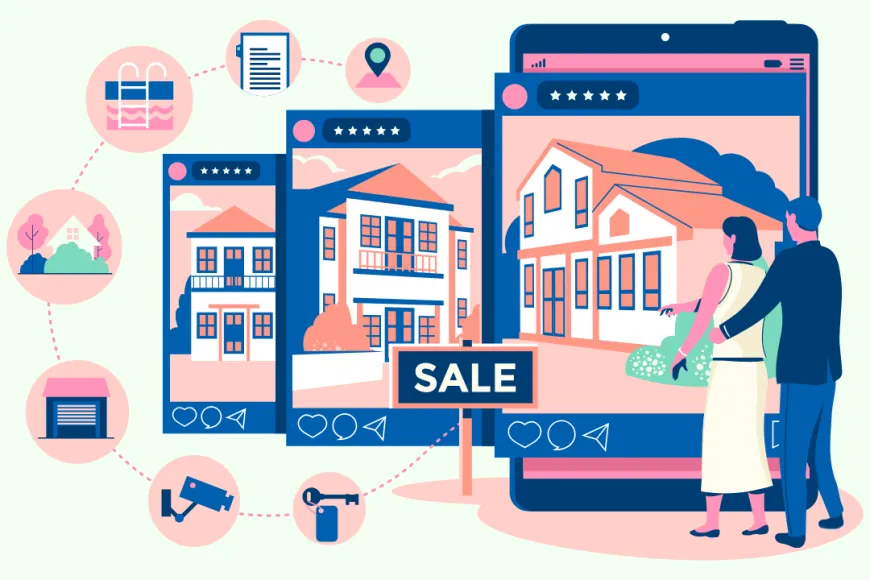How to Build a High-Performing Real Estate App for Success
The real estate industry is undergoing a digital transformation, with technology reshaping the way properties are bought, sold, rented, and managed

In today’s digital age, mobile apps have become an essential tool for businesses in every sector, and the real estate industry is no exception. Consumers increasingly rely on mobile devices to browse properties, connect with agents, and manage transactions. For real estate professionals and businesses, building a high-performing app is crucial to staying competitive and meeting the evolving needs of their target market. Appkodes Real Estate App Development Company specializes in delivering cutting-edge mobile solutions that help real estate businesses stay ahead of the curve.
A successful real estate app can help users quickly find properties that match their needs, while offering convenient features such as virtual tours, property comparisons, and real-time notifications. However, achieving this level of success requires a well-executed app development strategy. Below are key strategies for building a high-performing real estate app that delivers a great user experience and drives success for your business.
Understanding the Target Market
Before diving into the development process, it's crucial to understand your target market and their unique needs. The real estate market is diverse, and different users will have different expectations from your app. Buyers, renters, sellers, landlords, and real estate agents all require distinct features and functionalities from a property app.
-
Buyers and Renters: Typically, they are looking for a seamless search experience with comprehensive filters, detailed property information, and easy access to listings. Features like virtual tours and the ability to compare properties are also valuable to this group.
-
Sellers and Landlords: They require a platform to list properties, manage leads, track engagement, and communicate with potential buyers or tenants.
-
Real Estate Agents: Agents need tools to manage property listings, interact with clients, schedule meetings, and communicate with other stakeholders.
-
Investors: Real estate investors often look for apps that offer in-depth market analysis, property valuations, and ROI calculations to make informed decisions.
By clearly defining your target audience, you can prioritize features that address the specific needs of these groups, ensuring the app resonates with them and provides real value.
Essential Features for a Real Estate App
To create a high-performing real estate app, it’s important to include features that enhance the user experience while providing real utility. Some of the essential features that every real estate app should have include:
-
Property Search and Filters: A powerful search function is the backbone of any real estate app. It should allow users to filter by price, location, property type, number of bedrooms, amenities, and more. This helps users quickly narrow down their choices and find properties that match their criteria.
-
User Profiles: By allowing users to create profiles, you can enhance the app’s personalization features. Users can save searches, bookmark their favorite properties, and receive customized recommendations based on their preferences.
-
Maps and Geolocation: Integrating maps and geolocation features helps users find properties near their current location or in a specific area they are interested in. This is especially useful for those who are unfamiliar with the neighborhood or city.
-
Virtual Tours and Augmented Reality: Virtual tours and AR features are gaining popularity in the real estate space, allowing users to explore properties remotely. This feature not only saves time for potential buyers or renters but also provides a more immersive and engaging experience.
-
Push Notifications: Push notifications are an effective way to keep users engaged and informed. By sending real-time updates about new listings, price drops, or open houses, you can ensure that users stay connected and engaged with the app.
These features are just the beginning. You may also want to consider adding tools for mortgage calculators, online payment processing, document management, or even a messaging system to facilitate communication between buyers and sellers.
Designing a Seamless User Experience (UX/UI)
A user-friendly interface and seamless user experience (UX) design are essential for a successful real estate app. If users find the app difficult to navigate or the design too complicated, they may abandon it in favor of a competitor’s app. Therefore, it is essential to design the app with simplicity and ease of use in mind.
-
Intuitive Navigation: Ensure that users can easily navigate the app and find what they are looking for. Make sure your search function is front and center, and allow users to quickly switch between features like property listings, saved searches, and profile settings.
-
Responsive Design: With mobile-first design becoming the norm, your app must perform flawlessly on both smartphones and tablets. The interface should adjust to different screen sizes without affecting functionality.
-
Consistent Branding: Consistency in design elements, such as colors, fonts, and layout, creates a cohesive and professional look. This helps build trust with users and ensures that the app represents your real estate business effectively.
Performance Optimization
One of the most important aspects of building a high-performing real estate app is ensuring that it is fast, responsive, and bug-free. Slow load times, unresponsive buttons, or crashes can frustrate users and drive them away. To avoid these issues, performance optimization should be a priority during the development phase.
-
Fast Load Times: Ensure that property listings, images, and maps load quickly. Users expect apps to be responsive, and long waiting times can result in high bounce rates.
-
Bug-Free Performance: Conduct extensive testing to identify and fix any bugs or glitches in the app before launch. A bug-free experience is crucial to gaining and retaining users.
-
Cross-Platform Performance: Your app should perform equally well on both Android and iOS platforms. This includes optimizing the app for different devices, screen sizes, and operating system versions.
Security and Data Privacy
Real estate apps involve the exchange of sensitive user data, including personal details, payment information, and property transaction history. Therefore, it’s essential to ensure that the app is secure and complies with data protection regulations.
-
Secure Login and Authentication: Implement multi-factor authentication (MFA) and secure login processes to ensure that user accounts are protected from unauthorized access.
-
Data Encryption: Encrypt user data to prevent it from being exposed during transmission. This helps protect users' privacy and ensures that their personal information is safe from cyber threats.
-
Compliance with Data Regulations: Ensure that the app complies with data privacy laws such as the GDPR (General Data Protection Regulation) and CCPA (California Consumer Privacy Act). Make sure your privacy policy is transparent and easy for users to understand.
Leveraging Emerging Technologies
Incorporating emerging technologies can further elevate your real estate app. Artificial Intelligence (AI), machine learning (ML), and augmented reality (AR) are just a few of the technologies that can add value to your app and enhance user experience.
-
AI and ML: AI can be used to provide personalized property recommendations based on user preferences and browsing history. ML can help identify market trends, predict property values, and offer more accurate property suggestions.
-
AR and VR: Augmented reality and virtual reality technologies can give users an immersive experience of a property without them having to visit it physically. These features are especially useful for high-end or commercial properties.
Post-Launch Monitoring and Updates
Once your real estate app is launched, it’s important to continuously monitor its performance and make updates based on user feedback. Using analytics tools, you can track user behavior, identify areas for improvement, and gain insights into which features are most popular. Regular monitoring helps ensure that your app stays relevant and user-friendly in the competitive real estate market.
-
User Feedback: Encourage users to leave reviews and ratings. Address negative feedback promptly and use it to improve the app’s functionality. Regularly engaging with users through surveys or in-app feedback features allows you to gain valuable insights into their experiences, helping you identify areas for improvement in your real estate app development.
-
Regular Updates: Release periodic updates to fix bugs, add new features, and improve security. This shows users that you are committed to providing them with a high-quality app experience. Updates also ensure that the app remains compatible with the latest mobile operating systems and devices, further enhancing the performance and user experience of your Real Estate App Development
Conclusion
Building a high-performing real estate app requires a thoughtful approach, including a clear understanding of your target audience, a focus on essential features, seamless UX/UI design, and a commitment to performance optimization. By integrating the latest technologies, ensuring security, and continuously improving based on feedback, you can create an app that enhances the property search process and keeps users engaged. With these strategies in place, your real estate app will stand out in the competitive digital marketplace and help drive business success
What's Your Reaction?
 Like
0
Like
0
 Dislike
0
Dislike
0
 Love
0
Love
0
 Funny
0
Funny
0
 Angry
0
Angry
0
 Sad
0
Sad
0
 Wow
0
Wow
0


















































